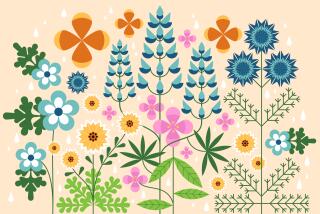A season of sun and shade
- Share via
September is a little summer and a little fall. It can have what might seem like the hottest weather of the year, but it is also when the seasons begin to change, to cool down, and plants know it.
Take a deep breath
Fall is the best time to plant most trees and shrubs, especially those that are drought resistant, such as natives and plants from other Mediterranean climates. But hold off until it cools after midmonth, or until October, unless you have a lot on your plate to plant this autumn. The irrefutable rationale for fall planting? It’s cooler and less stressful, plants need dramatically less water (and winter rains will help), and roots tend to grow during the autumn months, so plants get thoroughly established before spring growth hits. Some gardeners, including me, plant permanent things such as trees, shrubs, ground covers and perennials only in late September through early March.
Can’t wait?
Some annuals do well planted early in the fall, including calendulas, Iceland poppies, pansies and stock. Or plant fall-flowering chrysanthemums that are nearly in bloom for quick effect. Many fall and winter vegetables can also be started right away, from broccoli to leaf lettuce. Brussels sprouts and cabbage need a long growing season, so they should be planted ASAP.
Surprise packages
Bulbs are as close to surefire as gardening gets, since all of the leaves and flowers are tightly folded into these papery little packages (corms are similar and just as much a sure thing). They start arriving this month, and the first to be planted are those that bloom in the fall, such as saffron and autumn crocus. Most Cape bulbs (freesia, homeria, sparaxis) can be planted right way, as can daffodils. October is fine too, but wait to plant tulips until winter (keep them in the fridge until then).
Beware the shadow
Shadows from trees and buildings will double in length between now and December, so be careful where you plant, or sun-loving annual vegetables and flowers might end up growing in too much shade. On the other hand, some areas under trees get more light as the sun gets lower. Areas that are barely beneath high tree branches are a favorite place for tulips and some other bulbs since they grow in sun and then bloom in light shade in spring, as the sun begins to climb. This helps flowers last longer.
Roses, the final act
Lightly prune and primp roses for one last fall flowering. Cut off all hips and spent flowers, fertilize and thoroughly water for a bloom nearly as good as spring’s. Powdery mildew on the tops of leaves or orange rust underneath can be serious problems in late summer and early fall; nurseries have specific fungicides and more natural controls that are sulfur based.
Sticky business
It’s no fun going out for the morning paper and walking into a sticky spider web. But those fat yellow and black or reddish garden spiders are after smaller game. These big spiders may seem creepy, but they’re not dangerous. They catch all sorts of insects (good and bad, unfortunately) and should be tolerated. By this time of the year, their neat circular webs are usually high up in trees. If not, they can be encouraged to go higher by simply knocking down their hair-entangling webs.
Wasps bring balance
Big wasps also deserve more respect, not because of their sting but because they are expert hunters, helping achieve a balance in gardens. It’s actually hard to provoke some of these larger wasps, like the narrow-waisted mud daubers (which have a mild sting). They hunt spiders and build those small mud nests found in garages. The narrow-waisted yellow and black wasps build those papery, upside-down umbrella nests under eaves. They will sting if provoked, but they also hunt often-destructive caterpillars. It’s the ground-dwelling yellow jackets without the thread-like waists that can be a pain and make a barbecue no fun.






